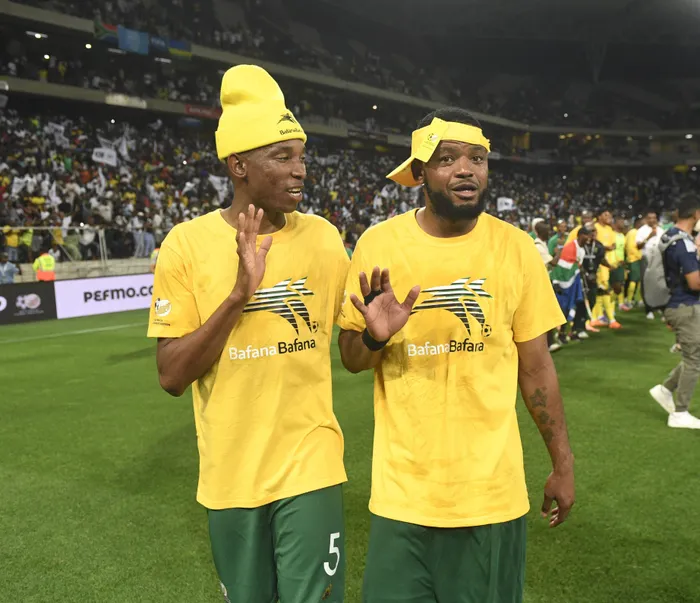From setbacks to success : inside Bafana Bafana's tense route to the World Cup
2026 FIFA WORLD CUP

Thalente Mbatha and Sipho Mbule of South Africa celebrate after their FIFA World Cup Qualifiers 2026 following their win against Rwanda. | BackpagePix
Image: BackpagePix
Bafana Bafana have made remarkable strides over the past few years, gradually reclaiming their place among Africa’s footballing giants. With their qualification for next year’s FIFA World Cup now secured, part of their long-term mission has been successfully accomplished.
Of course, the focus now turns to preparation for the global spectacle. Though the tournament spans just a month, the build-up and planning demand months of meticulous work to ensure readiness and competitiveness, as the best nations in world football prepare to converge across the United States, Canada, and Mexico.
As has become something of a recurring theme for South Africa, their route to qualification was anything but smooth. Both on and off the field, they managed to keep the nation on edge, ensuring that their path to the global stage was not straightforward — needing the very last match of the qualifiers to secure their ticket to the World Cup.
Having been comfortably placed at the top of Group C heading into the final rounds, Bafana were handed a blow when Fifa docked three points for fielding an ineligible Teboho Mokoena. Even with that setback, they still had qualification within reach.
However, a goalless draw against Zimbabwe in the penultimate match — a game they should have won — left them with a nervy finish. They ultimately steadied themselves with a commanding 3-0 victory over Rwanda to finish top of their group and book their place among Africa’s representatives.
Here, we reflect on the top five moments from those tense final fixtures that sealed their qualification.
Mbatha’s golden touch
Orlando Pirates midfielder Thalente Mbatha’s thunderous strike was far more than just a spectacular goal that left Kaizer Chiefs goalkeeper Fiacre baffled. It was a defining moment that settled early nerves, inspired belief, and allowed Bafana to control the rhythm of the game — shutting down any potential threat from the visitors.
The great wall
Despite the disappointment of the goalless draw against Zimbabwe, the defensive resilience displayed was equally significant. Zimbabwe had a few good chances to snatch points, but Bafana’s backline held firm. Crucially, South Africa didn’t concede a single goal across their final two matches — a decisive factor in collecting four vital points that ultimately proved crucial in their goal difference and group standing.
Sharp tactical tweaks
Much didn’t go as planned against Zimbabwe, particularly when it came to breaking down their stubborn defensive block. However, Broos’ decision to adjust his midfield structure by pairing Teboho Mokoena and Mbatha brought balance and creativity. The duo’s understanding strengthened both the attack and defense, adding much-needed fluidity heading into the decisive final game.
Quality depth in defense
Hugo Broos faced growing defensive challenges as injuries and suspensions reduced his options, particularly in central defense. When Mbekezeli Mbokazi was sent off in the last match, the Belgian turned to young TS Galaxy defender Khulumani Ndamane.
The youngster rose to the occasion alongside Nkosinathi Sibisi, handling the pressure with composure and earning his place in Broos’ expanding list of dependable defensive options ahead of the Africa Cup of Nations later this year.
Local is lekker
Throughout his tenure, Broos has made bold and sometimes questioned decisions regarding squad selection. Yet time and again, he has been vindicated. His decision to build a side composed of roughly 95% PSL-based players — competing successfully against teams filled with overseas-based stars — is a testament to his belief in local talent. It underscores not only the unity within the squad but also their collective willingness to fight for each other and for their coach.
Related Topics: